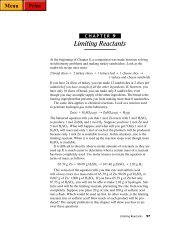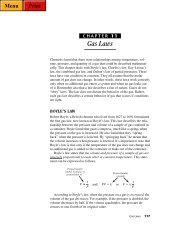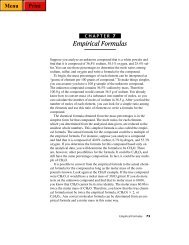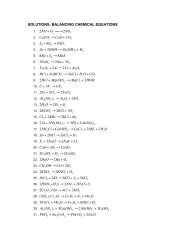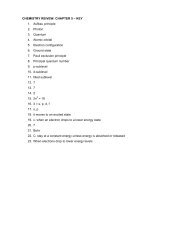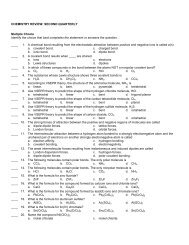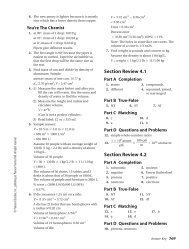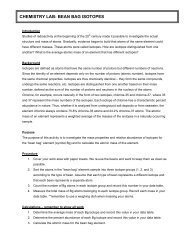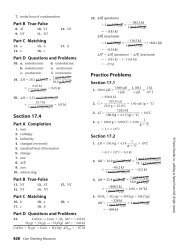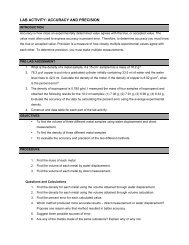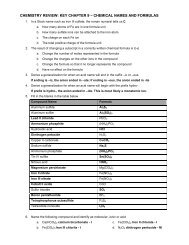Notes: Activity 5 - The Electronic Behavior of Atoms
Notes: Activity 5 - The Electronic Behavior of Atoms
Notes: Activity 5 - The Electronic Behavior of Atoms
Create successful ePaper yourself
Turn your PDF publications into a flip-book with our unique Google optimized e-Paper software.
<strong>The</strong> Electromagnetic<br />
Spectrum, Spectroscopy,<br />
and Atomic Structure
Electromagnetic Spectrum<br />
• <strong>The</strong> whole range <strong>of</strong> electromagne0c radia0on<br />
• Includes the following<br />
• Radio waves<br />
• Microwaves<br />
• Infrared Waves<br />
• Visible Light<br />
• Ultraviolet Waves<br />
• X-‐rays<br />
• Gamma Rays<br />
• <strong>The</strong> only difference between them is the amount <strong>of</strong> energy they<br />
contain
Visible Light<br />
• In 1665 Isaac Newton discovered that white light<br />
was composed <strong>of</strong> all the colors in the rainbow.<br />
• Used a prism to separate white light into individual colors<br />
• Makes up a very narrow por0on <strong>of</strong> the<br />
electromagne0c spectrum<br />
• Different colors carry a different amount <strong>of</strong> energy
• Our eyes & brain interpret<br />
different amounts <strong>of</strong><br />
energy as different colors<br />
• Violet has the most amount<br />
<strong>of</strong> energy<br />
• Red has the least amount <strong>of</strong><br />
energy
Continuous Spectrum<br />
• A parade <strong>of</strong> all the colors<br />
are in visible light<br />
• Can be produced by a<br />
hea0ng a solid, a liquid or<br />
an opaque gas to a fairly<br />
high temperature<br />
(several thousand<br />
degrees Fahrenheit)<br />
• Example: rainbow
Emission Spectrum<br />
• <strong>The</strong> spectrum <strong>of</strong> light released from excited atoms<br />
<strong>of</strong> an element<br />
• <strong>The</strong> light emiWed by an element separates into<br />
discrete lines<br />
• Each element produces its own unique set <strong>of</strong> lines<br />
• Can be used to iden0fy an element
How is an emission line spectrum<br />
created?<br />
• According to Bohr’s Model<br />
<strong>of</strong> the atom, electrons on<br />
an energy level contain a<br />
certain amount <strong>of</strong> energy<br />
• <strong>The</strong>se electrons can only<br />
move between energy<br />
levels by gaining or losing<br />
an exact amount <strong>of</strong> energy<br />
• This is known as a Quantum <strong>of</strong><br />
Energy
Quantized Energy<br />
• Quan0zed energy is like<br />
a staircase<br />
• It takes a certain amount<br />
<strong>of</strong> energy to go up and<br />
down the stairs<br />
• Con0nuous energy is like<br />
a ramp<br />
• Any amount <strong>of</strong> energy can<br />
be used to go up and down<br />
the ramp
• When electrons absorb<br />
energy, they only need a<br />
quantum <strong>of</strong> energy to to<br />
move to a higher energy<br />
level<br />
• Electrons cannot stay in<br />
this new energy level, so<br />
they fall back to a lower<br />
energy level<br />
• When they fall back, they<br />
release (emit) this energy in<br />
the form <strong>of</strong> light<br />
• Emit only certain amounts <strong>of</strong><br />
energy, resul0ng in specific<br />
colors <strong>of</strong> light
• Each element has its own unique Bohr model with<br />
different energy spacing between each level<br />
• So each atom produces its own set <strong>of</strong> unique colors
• hWp://<br />
www.bbc.co.uk/<br />
schools/gcsebitesize/<br />
science/edexcel/<br />
electromagne0c_spe<br />
ctrum/<br />
electromagne0cspect<br />
rumact.shtml<br />
• hWp://video.pbs.org/<br />
video/2219781967/<br />
• hWp://<br />
www.schooltube.co<br />
m/video/<br />
6ea0d020a582f8d6b<br />
1c1/<strong>The</strong>-‐<br />
Electromagne0c-‐<br />
Spectrum
TYPES OF VISIBLE SPECTRA
EMISSION SPECTRUM<br />
• A range <strong>of</strong> frequencies <strong>of</strong> electromagne0c<br />
radia0on emiWed by an atom s0mulated by either<br />
heat or electricity
EMISSION SPECTRUM<br />
• Bohr aWempted to explain emission spectra
BOHR MODEL<br />
• Electrons orbit nucleus in<br />
specific, fixed orbits called<br />
energy levels.<br />
• Each atom has certain,<br />
allowed orbits which<br />
correspond to certain<br />
allowed energies.
EMISSION SPECTRUM<br />
• hWp://www.youtube.com/watch?v=QI50GBUJ48s
EMISSION SPECTRA:<br />
EXPLAINED<br />
1. An electron in its ground state ABSORBS a<br />
quantum <strong>of</strong> energy and moves to an excited<br />
state<br />
• Ground state – lowest energy state<br />
• Excited state – higher energy state<br />
• Quantum – a discrete or particular amount
2. <strong>The</strong> electron falls back to the ground state and<br />
RELEASES energy in the form <strong>of</strong> light.
EMISSION SPECTRA<br />
• hWp://www.youtube.com/watch?v=8TJ2GlWSPxI
EMISSION SPECTRUM:<br />
QUESTIONS<br />
1. Where was the ground state?<br />
2. Where were the excited states?<br />
3. What energy level did the electron move to<br />
when it absorbed red light?<br />
4. Why did it fall back to its ground state from the<br />
excited state?<br />
5. What energy level did the electron move to<br />
when it absorbed purple light?<br />
6. Compare and explain the observed transi0ons.
IN SUMMARY



